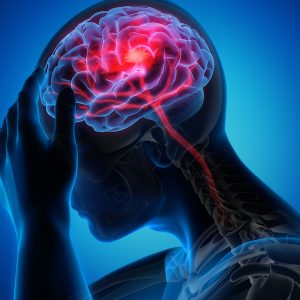Stroke

Stroke, also known as cerebrovascular accident (CVA) or cerebrovascular disorder (CVD), is a significant cause of mortality worldwide. It ranks as the third leading cause of death, following heart disease and cancer. A stroke is a medical emergency that occurs due to a sudden reduction in blood flow to brain cells, leading to cell death from insufficient oxygen supply. There are two main types of stroke: ischemic, which is caused by a blockage in a blood vessel supplying the brain, and hemorrhagic, which involves bleeding into or around the brain. Approximately 88% of strokes are ischemic, typically resulting from a blocked artery.
Transient ischemic attacks (TIAs), often referred to as ministrokes, can serve as an early warning sign of a potential ischemic stroke. TIAs are caused by a brief interruption in blood flow to part of the brain. Since the blood supply is quickly restored, brain tissue may not sustain permanent damage as it does in a stroke.
### Causes and Risk Factors
Strokes have multiple risk factors, some of which are beyond control while others can be managed.
**Non-Modifiable Risk Factors:**
– Age
– Gender (higher incidence in males)
– Genetic predisposition
**Modifiable Risk Factors:**
– Atherosclerosis
– Hypertension
– Diabetes
– Sedentary lifestyle
– Obesity
– High cholesterol
– Smoking
– Alcohol consumption
– Cardiac rhythm disturbances
### Symptoms
Stroke symptoms typically appear suddenly and vary based on the affected brain region. Specific arteries supply different brain areas, and a blockage in any of these can lead to corresponding deficits. For instance, a blockage in an artery supplying the area controlling the left arm can cause weakness or paralysis in that arm.
The five most common signs of a stroke include:
1. Sudden numbness or weakness of the face, arm, or leg, especially on one side of the body (hemiplegia).
2. Sudden confusion, trouble speaking, or difficulty understanding speech (aphasia).
3. Sudden trouble seeing in one or both eyes (monocular or binocular vision disturbance).
4. Sudden dizziness, trouble walking, or loss of balance or coordination, often due to strokes in the posterior circulation.
5. Sudden severe headache with no known cause, which may indicate hemorrhage or infarction.
The acronym B.E.F.A.S.T. can help remember these symptoms: Balance disturbance, Eye disturbance (double vision), Facial drooping or asymmetry, Arm weakness, Speech disturbance, and noting the Time of onset to ensure prompt medical intervention.
### Diagnosis
Diagnosis relies on the sudden onset of neurological symptoms and a thorough history provided by the patient or an observer. Neurological symptoms that appear abruptly in a specific neurovascular territory are typically attributed to a stroke. A CT scan performed immediately after a stroke is often normal in ischemic strokes, whereas an MRI with diffusion imaging is sensitive enough to detect acute infarctions.
### Treatment
Immediate medical attention is crucial for anyone exhibiting sudden neurological symptoms, as specific treatments can reopen the blocked blood vessels supplying the brain. Intravenous thrombolysis, if administered within a 4.5-hour window, can dissolve clots and reverse neurological deficits. In select cases, mechanical thrombectomy via an endovascular procedure can also reverse deficits. Early hospital admission at the onset of symptoms is critical. Additional treatments include antiplatelet drugs, anticoagulants, and medications to control high blood pressure to prevent recurrence.
### Prevention
Preventing strokes involves managing major risk factors. Controlling high blood pressure and diabetes, monitoring and lowering high cholesterol levels, and taking antiplatelet drugs like aspirin to prevent ischemic strokes are key strategies. Anticoagulants are prescribed for cardioembolic strokes associated with atrial fibrillation.
Lifestyle modifications are essential in stroke prevention, including quitting smoking, limiting alcohol intake to no more than two drinks per day, exercising regularly, and maintaining a healthy weight. Regular medical checkups can help identify and manage stroke risk factors early. Adopting a stress-free lifestyle, consuming healthy food, and engaging in regular physical activity are vital elements of prevention.